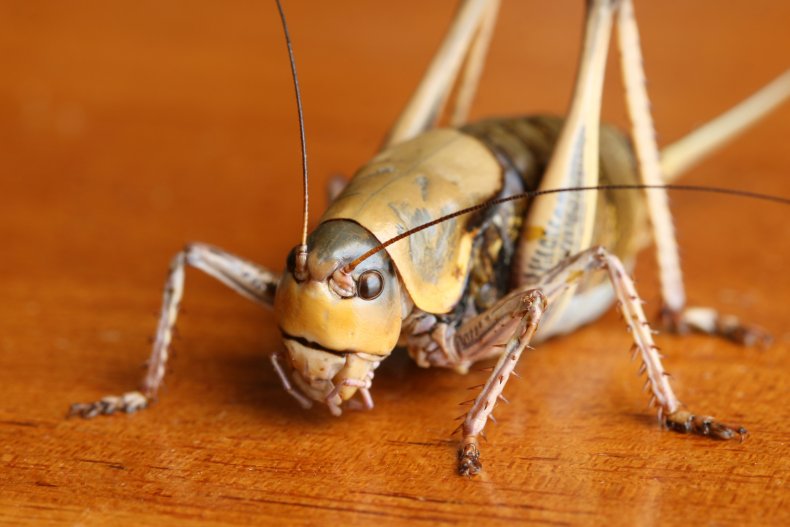TerriHaute
Hoosier Gardener
Swarms of Mormon Crickets Engulf Oregon Farms: 'Truly Biblical'
BY JESSICA THOMSON ON 6/29/22 AT 10:27 AM ED
Mormon crickets, giant insects that descend upon areas in huge swarms, are destroying millions of acres of farmland in Oregon.
Each cricket can grow to over two inches long, and when swarming, can ravage fields of crops in a matter of hours. Their name comes from the fact that they ruined the fields of Mormon settlers in Utah in the 1800s, and have plagued farmland ever since.
In the face of increased temperatures as a result of worsening droughts in the U.S., the infestations of the crickets have become far worse.
According to the Associated Press, in 2021 alone, 10 million acres of Oregon rangeland in 18 counties were damaged by insect swarms.

The infestations are "truly biblical," Skye Krebs, a rancher, told AP. "On the highways, once you get them killed, then the rest of them come."
Despite their name, Mormon crickets aren't actually crickets, instead being shield-backed katydids. They cannot fly, but during the swarming season they can travel over a mile per day on foot. The swarms are part of their life cycle.
They hatch in the spring once soil temperatures reach 40 degrees Fahrenheit, with the juvenile nymphs taking around 60 days to reach full adulthood. Within two weeks of adulthood, breeding begins.
Scientists do not really understand what triggers the mass swarming behaviors, whereupon the usually low population explodes to migrating groups, including millions of individuals.
The crickets are thought to keep moving to forage for sources of proteins and salts wherever they can, crucial to their survival, but also to avoid being cannibalised by the other crickets coming up behind them, leading to a self-regulating unstoppable swarm that constantly moves forwards.
April Aamodt lives in Arlington, Oregon, where there was an enormous outbreak in 2017. She fought off crickets from the swarm, the largest since the 1970s, using gardening equipment.
"I got the lawnmower out and I started mowing them and killing them," she told AP. "I took a straight hoe and I'd stab them."
To help combat the effects of the cricket swarms, there is a new initiative whereupon the Oregon Department of Agriculture (ODA) will survey the land of private landowners like farmers and ranchers, and if they find more than three Mormon crickets per square yard, they will be offered treatment with the pesticide diflubenzuron. Diflubenzuron must be used quickly, however, as it is only effective against juveniles.
According to AP, USDA's Animal and Plant Health Inspection Service (APHIS) said diflubenzuron is "a restricted use pesticide due to its toxicity to aquatic invertebrates," but risks are low.
The use of this pesticide has triggered protests from environmentalists, who are worried about its impact on the ecosystems of the grasslands, as the chemicals can affect other insects including honeybees and other pollinators.
The Xerces Society for Invertebrate Conservation and the Center for Biological Diversity issued a lawsuit against APHIS, accusing it of harming ecosystems.
Some other methods of control available for defense against these cricket invaders include physical barriers, as they are flightless, loud music, and using a biopesticide based on the fungus Nosema locustae that produces spores of which kill crickets and other closely related insects by destroying their digestive system.

 www.newsweek.com
www.newsweek.com
BY JESSICA THOMSON ON 6/29/22 AT 10:27 AM ED
Mormon crickets, giant insects that descend upon areas in huge swarms, are destroying millions of acres of farmland in Oregon.
Each cricket can grow to over two inches long, and when swarming, can ravage fields of crops in a matter of hours. Their name comes from the fact that they ruined the fields of Mormon settlers in Utah in the 1800s, and have plagued farmland ever since.
In the face of increased temperatures as a result of worsening droughts in the U.S., the infestations of the crickets have become far worse.
According to the Associated Press, in 2021 alone, 10 million acres of Oregon rangeland in 18 counties were damaged by insect swarms.

The infestations are "truly biblical," Skye Krebs, a rancher, told AP. "On the highways, once you get them killed, then the rest of them come."
Despite their name, Mormon crickets aren't actually crickets, instead being shield-backed katydids. They cannot fly, but during the swarming season they can travel over a mile per day on foot. The swarms are part of their life cycle.
They hatch in the spring once soil temperatures reach 40 degrees Fahrenheit, with the juvenile nymphs taking around 60 days to reach full adulthood. Within two weeks of adulthood, breeding begins.
Scientists do not really understand what triggers the mass swarming behaviors, whereupon the usually low population explodes to migrating groups, including millions of individuals.
The crickets are thought to keep moving to forage for sources of proteins and salts wherever they can, crucial to their survival, but also to avoid being cannibalised by the other crickets coming up behind them, leading to a self-regulating unstoppable swarm that constantly moves forwards.
April Aamodt lives in Arlington, Oregon, where there was an enormous outbreak in 2017. She fought off crickets from the swarm, the largest since the 1970s, using gardening equipment.
"I got the lawnmower out and I started mowing them and killing them," she told AP. "I took a straight hoe and I'd stab them."
To help combat the effects of the cricket swarms, there is a new initiative whereupon the Oregon Department of Agriculture (ODA) will survey the land of private landowners like farmers and ranchers, and if they find more than three Mormon crickets per square yard, they will be offered treatment with the pesticide diflubenzuron. Diflubenzuron must be used quickly, however, as it is only effective against juveniles.
According to AP, USDA's Animal and Plant Health Inspection Service (APHIS) said diflubenzuron is "a restricted use pesticide due to its toxicity to aquatic invertebrates," but risks are low.
The use of this pesticide has triggered protests from environmentalists, who are worried about its impact on the ecosystems of the grasslands, as the chemicals can affect other insects including honeybees and other pollinators.
The Xerces Society for Invertebrate Conservation and the Center for Biological Diversity issued a lawsuit against APHIS, accusing it of harming ecosystems.
Some other methods of control available for defense against these cricket invaders include physical barriers, as they are flightless, loud music, and using a biopesticide based on the fungus Nosema locustae that produces spores of which kill crickets and other closely related insects by destroying their digestive system.

Swarms of Mormon Crickets Engulf Oregon Farms: 'Truly Biblical'
The two-inch-long insects damaged crops on 10 million acres of Oregon farmland last year.


